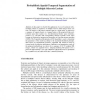Free Online Productivity Tools
i2Speak
i2Symbol
i2OCR
iTex2Img
iWeb2Print
iWeb2Shot
i2Type
iPdf2Split
iPdf2Merge
i2Bopomofo
i2Arabic
i2Style
i2Image
i2PDF
iLatex2Rtf
Sci2ools
ECCV
2004
Springer
2004
Springer
Probabilistic Spatial-Temporal Segmentation of Multiple Sclerosis Lesions
Abstract. In this paper we describe the application of a novel statistical videomodeling scheme to sequences of multiple sclerosis (MS) images taken over time. The analysis of the image-sequence input as a single entity, as opposed to a sequence of separate frames, is a unique feature of the proposed framework. Coherent space-time regions in a four-dimensional feature space (intensity, position (x,y), and time) and corresponding coherent segments in the video content are extracted by unsupervised clustering via Gaussian mixture modeling (GMM). The Expectation-Maximization (EM) algorithm is used to determine the parameters of the model according to the maximum likelihood principle. MS lesions are automatically detected, segmented and tracked in time by context-based classification mechanisms. Qualitative and quantitative results of the proposed methodology are shown for a sequence of 24 T2-weighted MR images, which was acquired from a relapsing-remitting MS patient over a period of appr...
Coherent Space-time Regions | Computer Vision | ECCV 2004 | Four-dimensional Feature Space | Statistical Videomodeling Scheme |
| Added | 01 Jul 2010 |
| Updated | 01 Jul 2010 |
| Type | Conference |
| Year | 2004 |
| Where | ECCV |
| Authors | Allon Shahar, Hayit Greenspan |
Comments (0)

